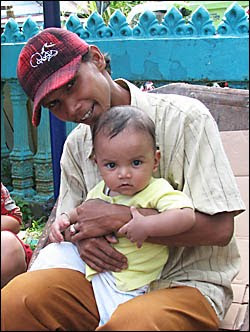It is a great learning experience for me to travel with Ebu Sastri for she is from this area and has such empathy with the people affected. I learn about the culture, the habits, the humour which is never far from the surface, and the needs of the people. She tells me in West Sumatra, it has one of the few matriarchal societies left in the world. By the respect people show to Ebu Sastri, I am now calling her the 'Queen of west Sumatra." When I returned to Padang, Ebu Sastri showed me round her office where she is secretary to the Parliament. Many parts of her building have collapsed and the rest have major cracks. Anxious women wait in her office to discuss their problems. So many show signs of trauma having lost many familiy members in the quake. Her days are long as she holds down a full time job and gives another 4 or 5 hours a day to Red Cross.
 Ebu Sastri (left) and me leaving the preschool which is housed in a tent. Photo: Wayne Ulrich.
Ebu Sastri (left) and me leaving the preschool which is housed in a tent. Photo: Wayne Ulrich.
Young children sing and dance in a pre school tent at Rauahatul Jannali. The school has 25 students who parents pay US$ 2.5 a month. Some parents cannot afford to pay. The teacher receives a salary of US$ 10 per month. Getting schools operating quickly in tents supplied by PMI have played a vital role in gradually alleviating stress and trauma. Two weeks ago many children spoke of having recurring nightmares when they sleep and dream their parents have been killed. Now the PMI PSP volunteers who visit schools and communities on a regular basis, say the nightmares experienced by the children are dissipating.

Kemisah sits on a wall outside her destroyed home. The Red Cross have given her a tent to live in. Photo: Wayne Ulrich
 Ebu Sastri right, and Pak Arifin 2nd from right, listen to Kemisah, who lost her home and all belongings in a village outside of Kota Pariaman. To date she has received a tent, sleeping mats, jerry cans, family kit, hygiene kit and mosquito nets. Photo: Wayne Ulrich
Ebu Sastri right, and Pak Arifin 2nd from right, listen to Kemisah, who lost her home and all belongings in a village outside of Kota Pariaman. To date she has received a tent, sleeping mats, jerry cans, family kit, hygiene kit and mosquito nets. Photo: Wayne Ulrich Landslides triggered by the earthquake, are starting to move again, threatening villages below on the shores of Lake Maninjau in Agam . We inspected this remote mountain area yesterday by helicopter Photo: Bob MCKerrow
Landslides triggered by the earthquake, are starting to move again, threatening villages below on the shores of Lake Maninjau in Agam . We inspected this remote mountain area yesterday by helicopter Photo: Bob MCKerrow Due to heavy rain, there is a continued concern that many communities living around the crater lake of Maninjau in Agam will continue to face the threat of renewed land and mud slides. Many villages have already been destroyed by landslides triggered by the earthquake. Now with the rainy season is approaching the government (fearing the landslides will continue to destroy the remaining settlements) has moved more than 3000 people to safer locations. These people may later return once the risks have reduced or will move to more permanent dwellings away from the danger areas. Tents supplied by the Hong Kong Red Cross to the PMI are being used to provide immediate shelter relief to these vulnerable families. Photo Bob McKerrow,
Due to heavy rain, there is a continued concern that many communities living around the crater lake of Maninjau in Agam will continue to face the threat of renewed land and mud slides. Many villages have already been destroyed by landslides triggered by the earthquake. Now with the rainy season is approaching the government (fearing the landslides will continue to destroy the remaining settlements) has moved more than 3000 people to safer locations. These people may later return once the risks have reduced or will move to more permanent dwellings away from the danger areas. Tents supplied by the Hong Kong Red Cross to the PMI are being used to provide immediate shelter relief to these vulnerable families. Photo Bob McKerrow,
















 Villagers in Padang getting water from the Indonesian Red Cross Tanker. Photo: Bob
Villagers in Padang getting water from the Indonesian Red Cross Tanker. Photo: Bob  Celebrating World
Celebrating World 



































